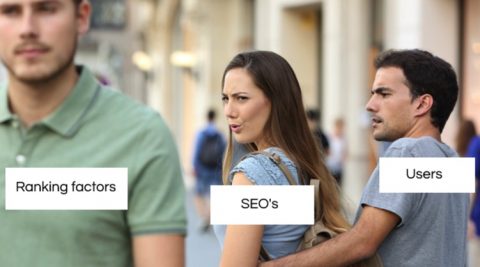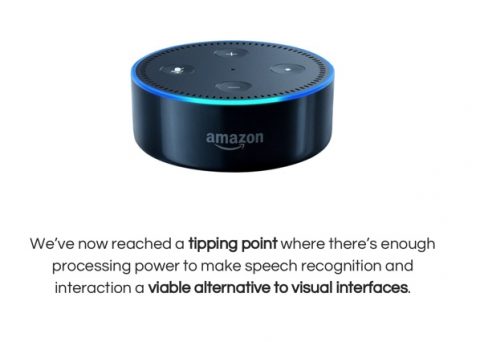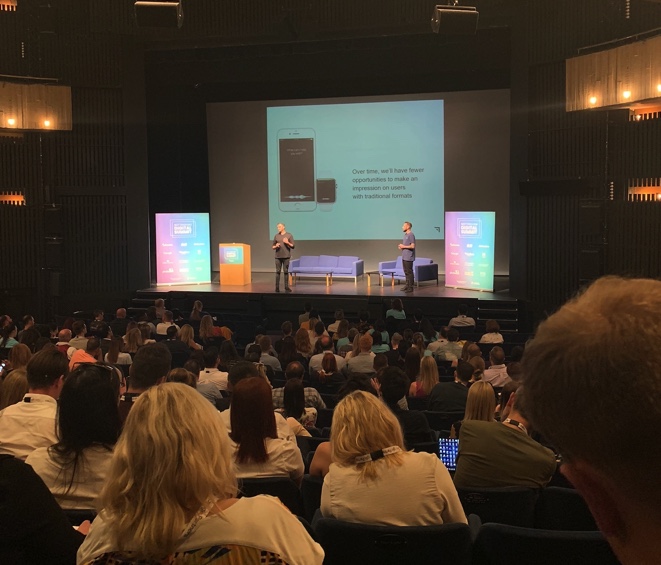In the morning session, Julio Taylor, creative director at Hallam, and Ben Wood, digital director at Hallam gave an entertaining presentation centred around the importance of uniting SEO and UX. According to Julio and Ben, the gap between design and SEO is getting shorter. Currently, SEO and UX teams don’t collaborate enough, and this has to change, therefore it is vital to bring SEO and design closer than ever before.
Why collaboration matters from an SEO point of view
Ben began the presentation by outlining the basic principles of SEO, before moving on to discuss why collaboration before these two teams matters from an SEO point of view.

A common conception is that SEO teams are obsessed with ranking high, and tend to neglect UX; this has to change.
Ben made reference to RankBrain, a machine learning-based search engine algorithm, which was confirmed by Google in 2015. RankBrain has two main features: understanding search queries, and measuring how people react with search results. As Google’s confidence in RankBrain grows, it is becoming more important for SEO teams to consider customer experience.
According to Ben, it is not sensible to blindly follow Google as this leads to problems in the long run. In order to be successful, SEO teams must take into account UX as this helps achieve a higher ranking. Sorting out page structure, for example, is one of the necessary strategies to implement. Typically, the SEO strategies with exceptional UX are rewarded.
So what makes good UX?
Julio stressed that designing based on data points alone is not enough; there has to be an emotional element.
According to Julio, it is very likely that Google understands why people are searching for stuff and that Google has a clear understanding of the context of user searches. Clearly then, there are signs that Google is taking UX very seriously. Either way, it doesn’t matter whether Google does or doesn’t consider UX, businesses HAVE to do it.
Currently, UX is governed by SEO limitations, and this has to change. Adding a human touch and emotion is absolutely necessary to provide a good user experience. Not only does this benefit the user, but this also helps with ranking, and is therefore vital for SEO. Google themselves are investing lots of resources into promoting good UX.
Furthermore, making a website unique is absolutely vital. Whether that is a good proposition, good photography or an elegant navigation system, it is vital to implement something which makes you unique in order to provide good UX.
Google’s UX playbooks –
- Retail & E-Commerce – https://services.google.com/fh/files/events/pdf_retail_ux_playbook.pdf
- Lead Gen – https://services.google.com/fh/files/events/pdf_leadgen_ux_playbook.pdf
- Travel – http://services.google.com/fh/files/events/pdf_travel_ux_playbook.pdf
- Finance – http://services.google.com/fh/files/events/pdf_finance_ux_playbook.pdf
- Real Estate – https://services.google.com/fh/files/events/pdf_realestate_ux_playbook.pdf
- News & Content – http://services.google.com/fh/files/events/pdf_news_ux_playbook.pdf
The Rise of Voice Interaction
The way users are using the internet is changing design in a big way. Julio describes us as being in the attention economy and therefore engagement is a precious resource. According to Julio, attention and engagement is the most important resource.
Until recently, accurate realistic voice processing was science-fiction. However, we have reached a tipping point where voice-only devices are now replacements for screens. Trends such as voice interaction are conditioning users to discover and expect information faster, and there are fewer opportunities to impress or get attention span from traditional formats such as screens.
Currently, voice searches account for 20% of total searches and this is predicted to rise to 50% by 2020. Thus, the role of traditional media and website is decreasing. It is clear that the amount of power held by voice search is exceptionally vast and there is no alternative but to take this as the primary focus for design.
According to Julio, voice interaction is the biggest UX challenge since the birth of the smartphone.

UX is your superpower in the SEO arms race
User behaviour is conditioning us to do SEO and design differently. Ultimately, this means we have to change the way we think about the two teams; this is no longer the job of a single department, collaboration is key. According to Julio, ‘UX is your superpower in the SEO arms race’.
User experience is a key part of any SEO strategy as this increases traffic and conversion rates. There are a number of ways in which the success of UX can be measured, including:
- Task Success
- Scroll Depth
- Bounce Rate
- Dwell time
- Attitudinal metrics
Google search console is a useful tool in observing how much google interacts with or crawls your website. This tool measures SERP (search engine results page). Another, more advanced UX measure worth considering is using custom Javascript events to measure content consumption depth, because ultimately when we’re talking about UX, we’re talking about CRO.
Navigating Tensions and Trade-Offs
Julio and Ben consider navigation and content to be the biggest tensions between SEO and design teams. However, there are a multitude of ways to optimise both of these for UX and SEO. For example, it is necessary for websites to contain some textual content from an SEO point of view in order for Google to understand it. By compromising and collaborating, SEO and UX teams can successfully reach a middle ground.
In order for SEO and UX teams to collaborate effectively, it is necessary for both teams to work from the same brief from the start of the process without exception. All teams must be briefed at the very start of the process, there can be no handover. Furthermore, it is important to make sure that all work is visible to all team members throughout the entire process. Lastly, each team member must learn to control their ego. It is important to truly believe in the mission, work as a team and learn from each other.




